Boat Haven Boatyard, Port Townsend, WA, 23-JAN-2020 – Winter time in PT is quiet. The tourists haven’t arrived, the harbor at Fort Hudson is full of boats wintering over, and the Boat Haven boat yard is full of boats being worked on.
Much of the conversation we had with other sailors about our crossing contained questions about whether, and oftentimes the assumption that, we were a full keel vessel.
Caro Babbo has a fin keel.

A fin keel, generally, means that the boat has less wetted area, weighs less, is more maneuverable and backs up in a harbor better than a full keel. But, a fin keel also means that vessel doesn’t want to go in a straight line as well as a full keel, isn’t as sea kindly as a full keel and won’t hove-to as well as a full keel.
The common wisdom for years has been that only a full-keel boat is a blue water boat, but that has been largely discarded as more and more fin keelers routinely cross oceans.
Except in a boatyard, we never see what a boat looks like below the water line.

Because I am a fin keel sailor, I expect every boat to be a fin keeler with not much wetted surface. This is what an 53-foot Amel Super Maramu 2000, the same boat as SV Delos†, looks like:

Versus this heavy displacement Westsail 43:

Look at how much boat is below the water line.

Mystericeti in the picture above is also a Westsail so we can see what the boat versus the drawing looks like. Also see how much of La Ruina, in the foreground, sticks into the water. It’s easy to see why these boats track (go in a straight line) so well.
As opposed to the boat in foreground here:

But even this vessel has a lot of wetted surface compared to many fin keelers today.
This is perhaps the ultimate in low wetted surface, non-foil* sailboats:

Above the water, the vessel on the left looks much slimmer to me than she does below. For many sailors she looks exactly as she should:

The vessel on the right provides a nice contrast and will feel like a palace below decks when compared to the other.
Who says a keel needs to be permanent?

Many sailors like swing keels because:
- Swinging the keel partway moves the center of lateral resistance fore and aft.
- Of course, with the keel all the way up, the boat can enter much shallower water than fixed keels.
- Many swing keel boats are designed to be easily trailerable, as this one is.
- The famous Jimmy Cornell likes swing keels because when the keel is up the boat will sideways across the water when hove-to in heavy (bad) weather
Here is a gallery of some of the vessel undercarriages at Boat Haven this past Sunday… then onto traditional wooden vessels. (Click on any picture to open the gallery.)
We, as a sport or industry, still build wooden boats. The wooden boats we build are generally impregnated with epoxy and are almost, though never referred to as such, wood reinforced plastic: they’ll last pretty much forever.
I’ve come to believe that boats prior to the middle twentieth century were never intended to last forever. The permanence of boats is something from the fiberglass times placed upon the past. Wood rots. A supermarket produce manager once told me that all of his product was rotting, his job was to sell it before it rotted enough to be unsaleable. The same is true of wooden boats, they are all rotting.
I find myself in a curious place, understanding that the very old wooden boats we see were never meant to last more than a decade or two and somehow finding a moral dilemma about the expense of maintaining and preserving these vessels. A surprising percentage of the commercial fishing boats we see in Alaska are wooden. Whether it makes sense to preserve and maintain these boats becomes a matter of simple economics: if it is not cost effective the boat is discarded, whether crushed or sold, and then replaced.
For many sailors, a wooden boat is a calling, whether to preserve the past, because a proper sailboat is wooden, or because the joy comes as much, if not more from the maintenance of a wooden boat as much as sailing her.
Some wooden boats in Boat Haven:

Robin Williams once said that cocaine was God’s way of telling you you have too much money. A wooden boat seems to be the same message:

Port Townsend wooden-boat shipwrights, who are among the best in the world, generally only do wooden repairs on wooden boats, renewing the work that needs replacement. The ribs on this vessel are sawn, not steamed or laminated.

The port side of the vessel is much worse. I would guess we are looking at a repair two or three times the average US household income, if repaired by professional shipwrights. Port Townsend is home to impressively skilled sailors who routinely take on major projects.

Caro Babbo floats in her slip in Ko’Olina. Jennifer and I enjoy our time ashore here in Port Townsend.
† Interestingly, the propeller is a large distance away from the rudder, meaning that water pushed over the rudder can not be used to increase steering response at slow speed in tight spaces.
* Foil monohulls seemed to be the coming things about five years ago with good-sized boats showing up in France, but they seem not have caught on. The foils, which were curved, retracted into the hull crossing the cabin.




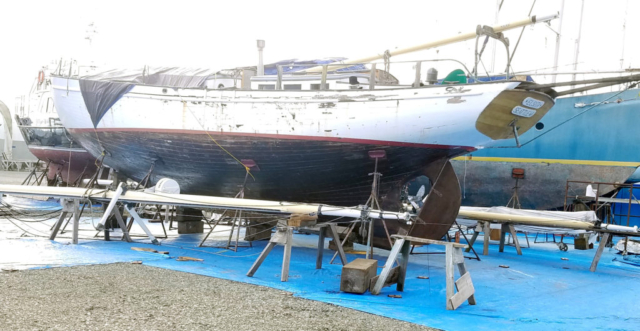
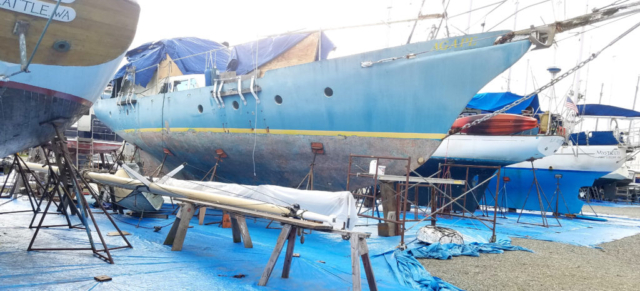
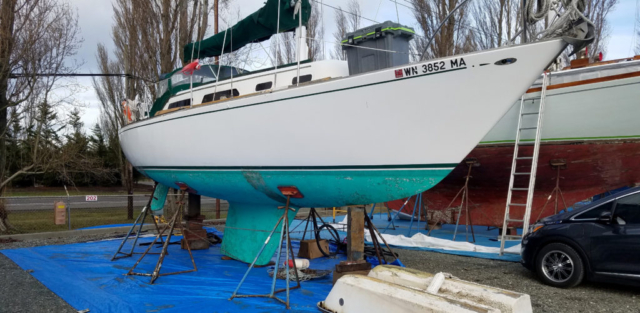
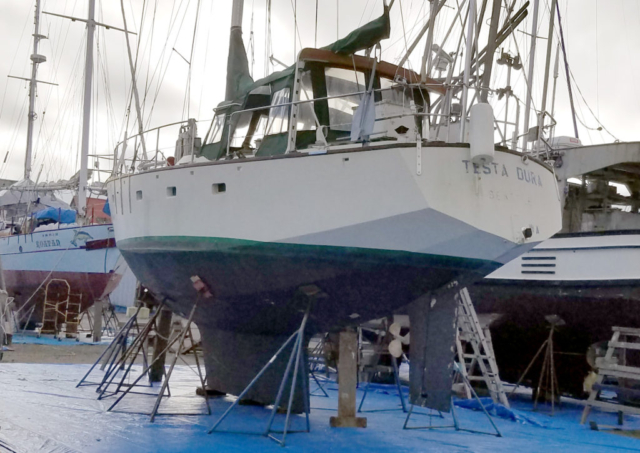
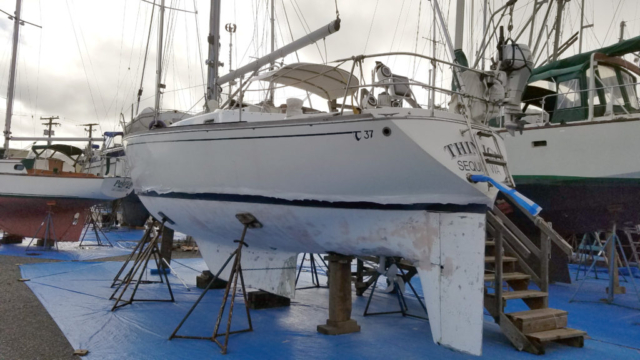
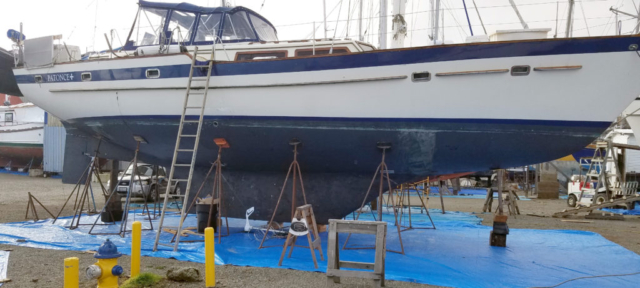
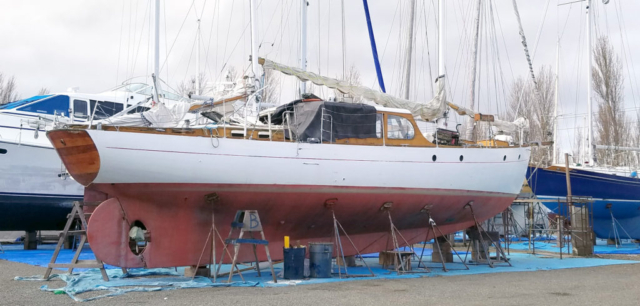
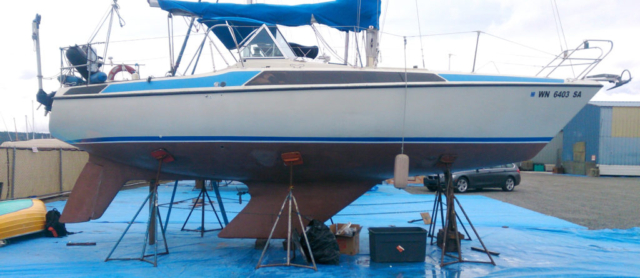
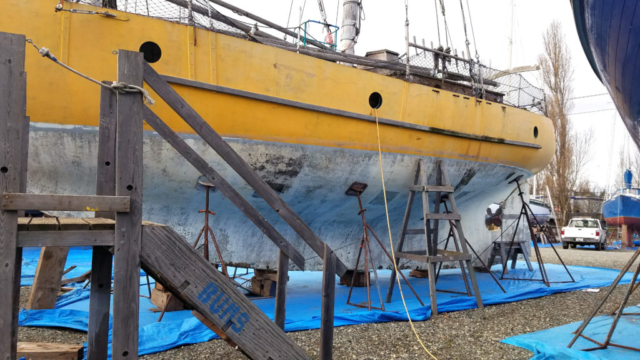
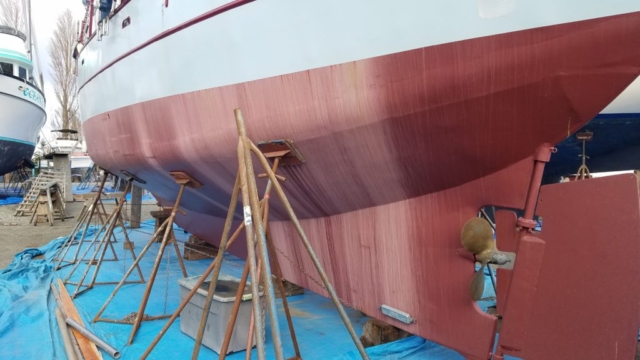
Great pictures, I love walking around boatyards and looking at boats. Sorry to hear about your father.
Cheers
Thank you for your condolences, Drew. I had intended to return to the boat yard and post some more pictures as a reply, which I will do.
Hi John, still in awe of your blue water achievement (did you get the email that said so?) and sorry to hear of your father’s death; at least he lived long enough to be very proud.
Your discussion of keels and construction methods brings back fond memories of when I called in and we walked among the yachts in PT.
As you know, we have a lifting, fin keel (Southerly 115). While it would apparently take us from the UK (where she, like our daughters and grandkids, is berthed) across oceans, later this year I have in mind that she will take us through the French canals (Paris and a few places whose names I have only seen on wine bottles) to the Med. One concession however to an easier life on the foredeck is the installation of a bow thruster! take us through the French canals (Paris and a few places whose names I have only seen on wine bottles) to the Med. One concession however to an easier life on the foredeck is the installation of a bow thruster!
Best wishes from Queensland Australia!
Peter
Sorry John I am hijacking your blog.
Peter is your Southerly the one in Scarborough that I surveyed?
Cheers
Drew, it’s in the UK somewhere.
Hi John, I got myself confused. I surveyed a Southerly 115 here in Queensland last year that had mast step issues and cracked fibreglass in the bilge. The sale fell through and the owner then found a guy who purchased her without a survey. I wonder what happened to the yacht after the new owner discovered all the issues? I love the Southerly 115 design.
Cheers
Hi Drew, we bought our Southerly from Chichester (UK) and currently store ashore in north Kent (where the forecast for today is 35 gusting 69!). There certainly are some in Queensland (I saw one, not a 115) on the Noosa river (which has a dangerous bar) last week, but we’re sailing in UK/Europe because that’s where the grandkids are!
John, I am the owner of the Spencer 42 ‘La Ruina’ pictured on your blog here.
You are correct, she does track incredibly well. Although for a full keel boat, she is rather sporty, and loves to point high, she will point at 28° to the wind and still go like hell, which makes her perfect for foreaching into a storm.
She has 8000 lbs of led in her keel, and is extremely sure footed, as I was learning to sail on her, she saved me from my own stupidity several times, and thus I have developed a profound love for this boat.
Personally I think she is the perfect boat. But perhaps I am a bit biased!
Currently we are still on the hard wrapping up a pretty extensive refit, should be back in the water in March.
– Nick
Nick,
I’m in Port Townsend for the next month or two. I would love to meet and see more of your boat.
Some dear friends in Juneau have a Spencer 53, which they love.
BTW, how did you find this post?
Funny, I actually just found this post again the way I did before, when researching the Spencer boats trying to find all of them.
I am back in the water now out sailing the sound getting ready to head to Alaska as soon as the weather breaks.
Nick, We never did meet. I’ll be back in PT on the 20th of January for a few days and then back mid-February for a month. Caro Babbo is still in Homer; we plan to bring her back to Southeast Alaska across the summer. I will DM you about some friend in Juneau with a Spencer 53(?).
Best,
–john